Analysis of Tesco's Business Environment: Stakeholder and Forces
VerifiedAdded on 2023/01/19
|10
|2770
|79
Report
AI Summary
This report provides a comprehensive analysis of Tesco's business environment. It begins with an introduction to the business environment and its impact on organizations, followed by an examination of the retail sector's nature. The report then delves into the micro and macro environmental forces affecting Tesco, including suppliers, customers, competition, demographic changes, and inflation. A PESTLE analysis is conducted to assess the impact of political, economic, social, technological, legal, and environmental factors on the organization. The report also explores the requirements of various stakeholders, such as customers, employees, shareholders, and suppliers, and evaluates the effectiveness of Tesco's responses to policy actions. The analysis highlights how Tesco navigates the complexities of its operating environment to achieve its business objectives.
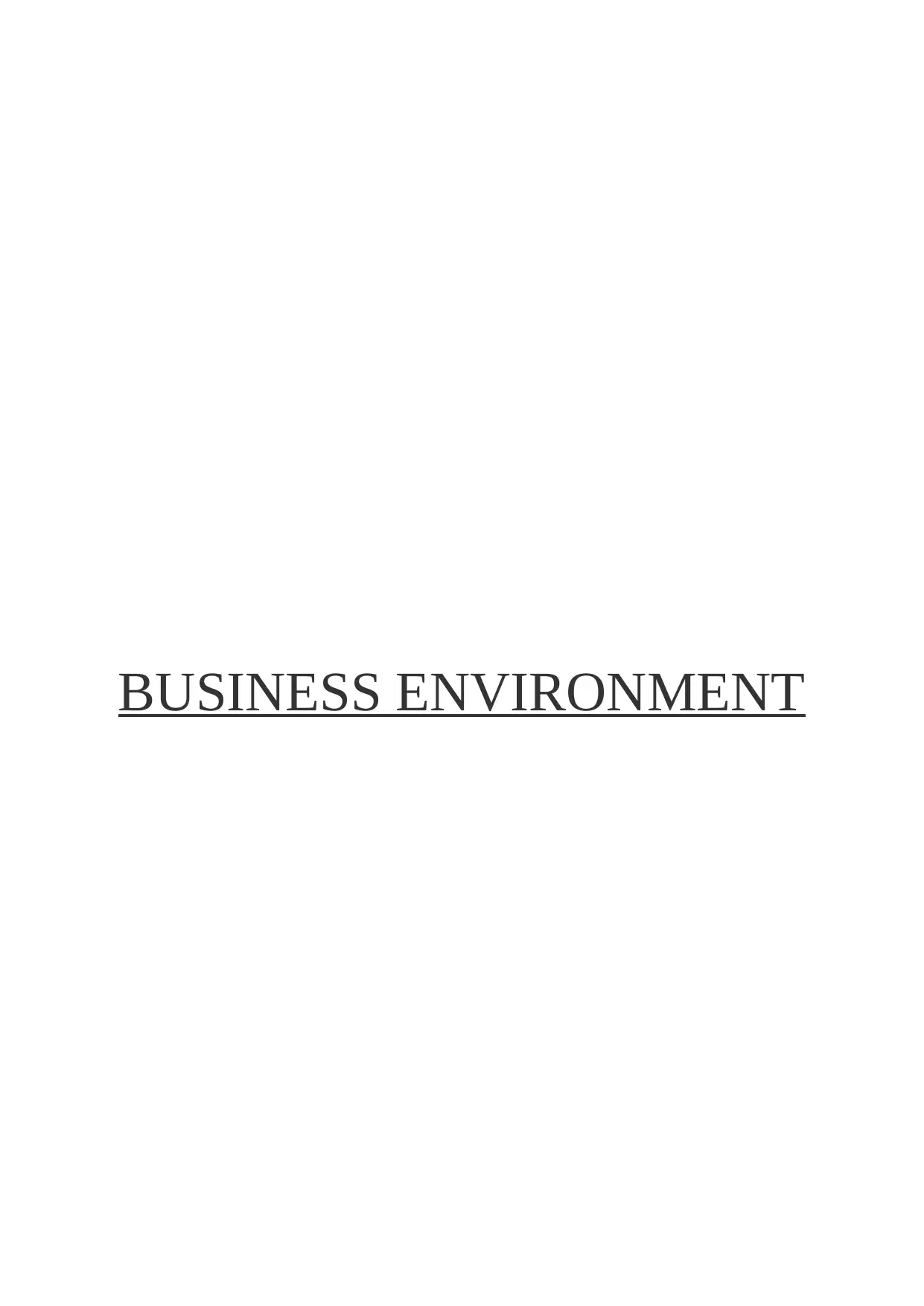
BUSINESS ENVIRONMENT
Paraphrase This Document
Need a fresh take? Get an instant paraphrase of this document with our AI Paraphraser

Table of Contents
INTRODUCTION................................................................................................................................3
MAIN BODY.......................................................................................................................................3
2. Nature of the retail sector environment...................................................................................3
3.The impact of environmental forces on organization at a micro and macro level...................4
4.Impact of environmental forces in organization......................................................................5
5.Requirements of a variety of stakeholders in retail organization.............................................6
6. Effectiveness of the stakeholder responses of organization to policy actions .......................6
CONCLUSION....................................................................................................................................7
REFERENCES.....................................................................................................................................8
INTRODUCTION................................................................................................................................3
MAIN BODY.......................................................................................................................................3
2. Nature of the retail sector environment...................................................................................3
3.The impact of environmental forces on organization at a micro and macro level...................4
4.Impact of environmental forces in organization......................................................................5
5.Requirements of a variety of stakeholders in retail organization.............................................6
6. Effectiveness of the stakeholder responses of organization to policy actions .......................6
CONCLUSION....................................................................................................................................7
REFERENCES.....................................................................................................................................8
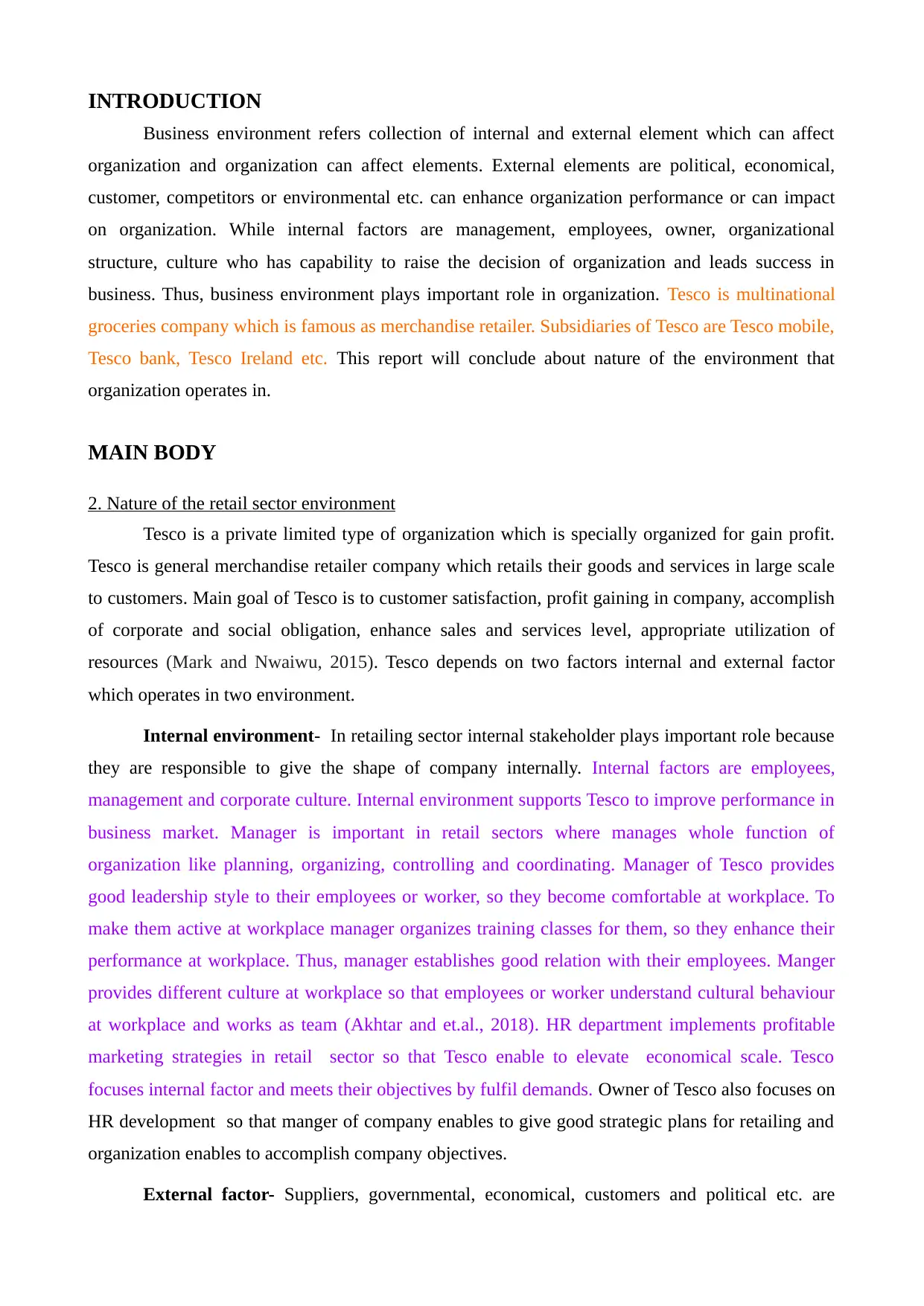
INTRODUCTION
Business environment refers collection of internal and external element which can affect
organization and organization can affect elements. External elements are political, economical,
customer, competitors or environmental etc. can enhance organization performance or can impact
on organization. While internal factors are management, employees, owner, organizational
structure, culture who has capability to raise the decision of organization and leads success in
business. Thus, business environment plays important role in organization. Tesco is multinational
groceries company which is famous as merchandise retailer. Subsidiaries of Tesco are Tesco mobile,
Tesco bank, Tesco Ireland etc. This report will conclude about nature of the environment that
organization operates in.
MAIN BODY
2. Nature of the retail sector environment
Tesco is a private limited type of organization which is specially organized for gain profit.
Tesco is general merchandise retailer company which retails their goods and services in large scale
to customers. Main goal of Tesco is to customer satisfaction, profit gaining in company, accomplish
of corporate and social obligation, enhance sales and services level, appropriate utilization of
resources (Mark and Nwaiwu, 2015). Tesco depends on two factors internal and external factor
which operates in two environment.
Internal environment- In retailing sector internal stakeholder plays important role because
they are responsible to give the shape of company internally. Internal factors are employees,
management and corporate culture. Internal environment supports Tesco to improve performance in
business market. Manager is important in retail sectors where manages whole function of
organization like planning, organizing, controlling and coordinating. Manager of Tesco provides
good leadership style to their employees or worker, so they become comfortable at workplace. To
make them active at workplace manager organizes training classes for them, so they enhance their
performance at workplace. Thus, manager establishes good relation with their employees. Manger
provides different culture at workplace so that employees or worker understand cultural behaviour
at workplace and works as team (Akhtar and et.al., 2018). HR department implements profitable
marketing strategies in retail sector so that Tesco enable to elevate economical scale. Tesco
focuses internal factor and meets their objectives by fulfil demands. Owner of Tesco also focuses on
HR development so that manger of company enables to give good strategic plans for retailing and
organization enables to accomplish company objectives.
External factor- Suppliers, governmental, economical, customers and political etc. are
Business environment refers collection of internal and external element which can affect
organization and organization can affect elements. External elements are political, economical,
customer, competitors or environmental etc. can enhance organization performance or can impact
on organization. While internal factors are management, employees, owner, organizational
structure, culture who has capability to raise the decision of organization and leads success in
business. Thus, business environment plays important role in organization. Tesco is multinational
groceries company which is famous as merchandise retailer. Subsidiaries of Tesco are Tesco mobile,
Tesco bank, Tesco Ireland etc. This report will conclude about nature of the environment that
organization operates in.
MAIN BODY
2. Nature of the retail sector environment
Tesco is a private limited type of organization which is specially organized for gain profit.
Tesco is general merchandise retailer company which retails their goods and services in large scale
to customers. Main goal of Tesco is to customer satisfaction, profit gaining in company, accomplish
of corporate and social obligation, enhance sales and services level, appropriate utilization of
resources (Mark and Nwaiwu, 2015). Tesco depends on two factors internal and external factor
which operates in two environment.
Internal environment- In retailing sector internal stakeholder plays important role because
they are responsible to give the shape of company internally. Internal factors are employees,
management and corporate culture. Internal environment supports Tesco to improve performance in
business market. Manager is important in retail sectors where manages whole function of
organization like planning, organizing, controlling and coordinating. Manager of Tesco provides
good leadership style to their employees or worker, so they become comfortable at workplace. To
make them active at workplace manager organizes training classes for them, so they enhance their
performance at workplace. Thus, manager establishes good relation with their employees. Manger
provides different culture at workplace so that employees or worker understand cultural behaviour
at workplace and works as team (Akhtar and et.al., 2018). HR department implements profitable
marketing strategies in retail sector so that Tesco enable to elevate economical scale. Tesco
focuses internal factor and meets their objectives by fulfil demands. Owner of Tesco also focuses on
HR development so that manger of company enables to give good strategic plans for retailing and
organization enables to accomplish company objectives.
External factor- Suppliers, governmental, economical, customers and political etc. are
⊘ This is a preview!⊘
Do you want full access?
Subscribe today to unlock all pages.

Trusted by 1+ million students worldwide
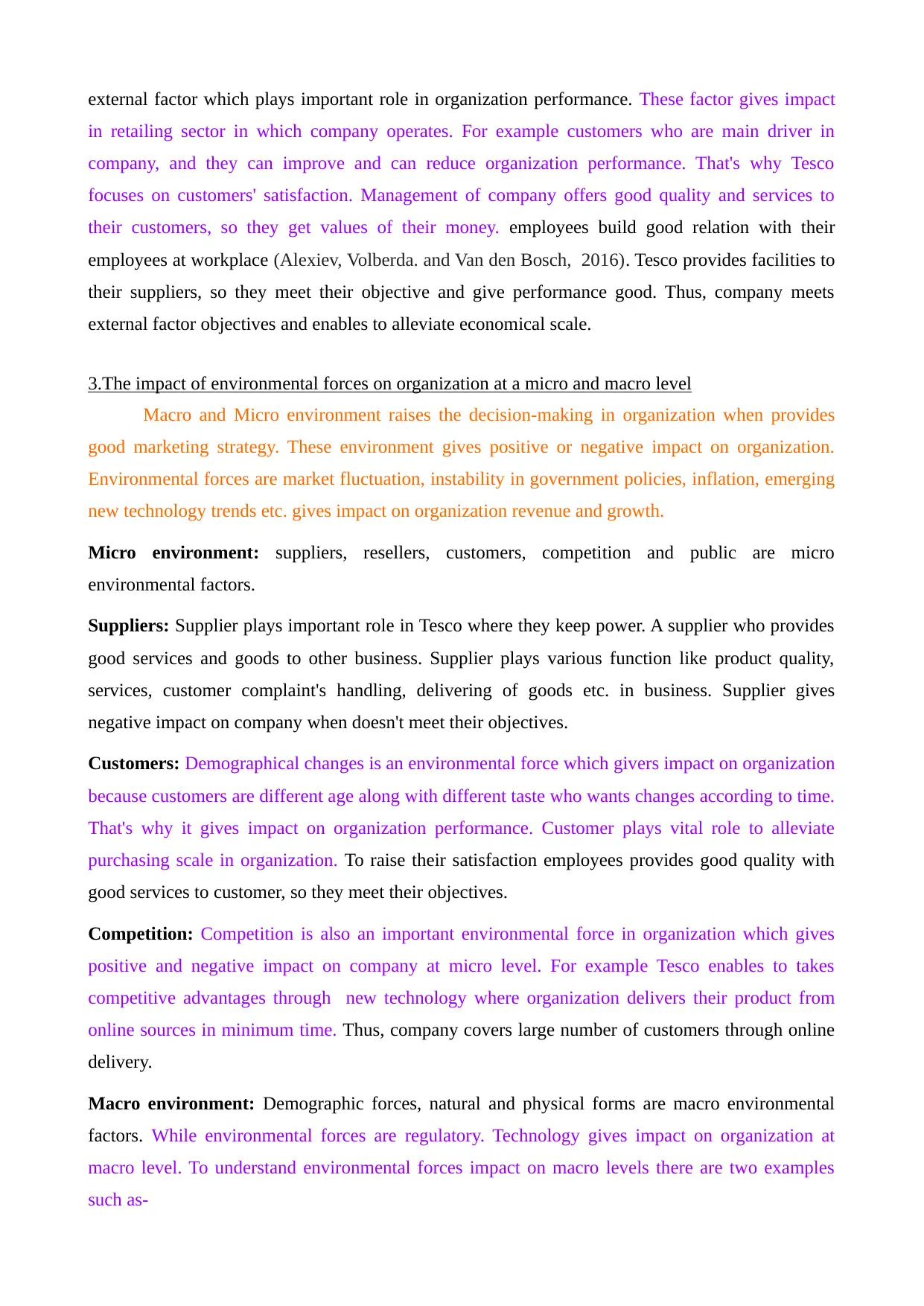
external factor which plays important role in organization performance. These factor gives impact
in retailing sector in which company operates. For example customers who are main driver in
company, and they can improve and can reduce organization performance. That's why Tesco
focuses on customers' satisfaction. Management of company offers good quality and services to
their customers, so they get values of their money. employees build good relation with their
employees at workplace (Alexiev, Volberda. and Van den Bosch, 2016). Tesco provides facilities to
their suppliers, so they meet their objective and give performance good. Thus, company meets
external factor objectives and enables to alleviate economical scale.
3.The impact of environmental forces on organization at a micro and macro level
Macro and Micro environment raises the decision-making in organization when provides
good marketing strategy. These environment gives positive or negative impact on organization.
Environmental forces are market fluctuation, instability in government policies, inflation, emerging
new technology trends etc. gives impact on organization revenue and growth.
Micro environment: suppliers, resellers, customers, competition and public are micro
environmental factors.
Suppliers: Supplier plays important role in Tesco where they keep power. A supplier who provides
good services and goods to other business. Supplier plays various function like product quality,
services, customer complaint's handling, delivering of goods etc. in business. Supplier gives
negative impact on company when doesn't meet their objectives.
Customers: Demographical changes is an environmental force which givers impact on organization
because customers are different age along with different taste who wants changes according to time.
That's why it gives impact on organization performance. Customer plays vital role to alleviate
purchasing scale in organization. To raise their satisfaction employees provides good quality with
good services to customer, so they meet their objectives.
Competition: Competition is also an important environmental force in organization which gives
positive and negative impact on company at micro level. For example Tesco enables to takes
competitive advantages through new technology where organization delivers their product from
online sources in minimum time. Thus, company covers large number of customers through online
delivery.
Macro environment: Demographic forces, natural and physical forms are macro environmental
factors. While environmental forces are regulatory. Technology gives impact on organization at
macro level. To understand environmental forces impact on macro levels there are two examples
such as-
in retailing sector in which company operates. For example customers who are main driver in
company, and they can improve and can reduce organization performance. That's why Tesco
focuses on customers' satisfaction. Management of company offers good quality and services to
their customers, so they get values of their money. employees build good relation with their
employees at workplace (Alexiev, Volberda. and Van den Bosch, 2016). Tesco provides facilities to
their suppliers, so they meet their objective and give performance good. Thus, company meets
external factor objectives and enables to alleviate economical scale.
3.The impact of environmental forces on organization at a micro and macro level
Macro and Micro environment raises the decision-making in organization when provides
good marketing strategy. These environment gives positive or negative impact on organization.
Environmental forces are market fluctuation, instability in government policies, inflation, emerging
new technology trends etc. gives impact on organization revenue and growth.
Micro environment: suppliers, resellers, customers, competition and public are micro
environmental factors.
Suppliers: Supplier plays important role in Tesco where they keep power. A supplier who provides
good services and goods to other business. Supplier plays various function like product quality,
services, customer complaint's handling, delivering of goods etc. in business. Supplier gives
negative impact on company when doesn't meet their objectives.
Customers: Demographical changes is an environmental force which givers impact on organization
because customers are different age along with different taste who wants changes according to time.
That's why it gives impact on organization performance. Customer plays vital role to alleviate
purchasing scale in organization. To raise their satisfaction employees provides good quality with
good services to customer, so they meet their objectives.
Competition: Competition is also an important environmental force in organization which gives
positive and negative impact on company at micro level. For example Tesco enables to takes
competitive advantages through new technology where organization delivers their product from
online sources in minimum time. Thus, company covers large number of customers through online
delivery.
Macro environment: Demographic forces, natural and physical forms are macro environmental
factors. While environmental forces are regulatory. Technology gives impact on organization at
macro level. To understand environmental forces impact on macro levels there are two examples
such as-
Paraphrase This Document
Need a fresh take? Get an instant paraphrase of this document with our AI Paraphraser
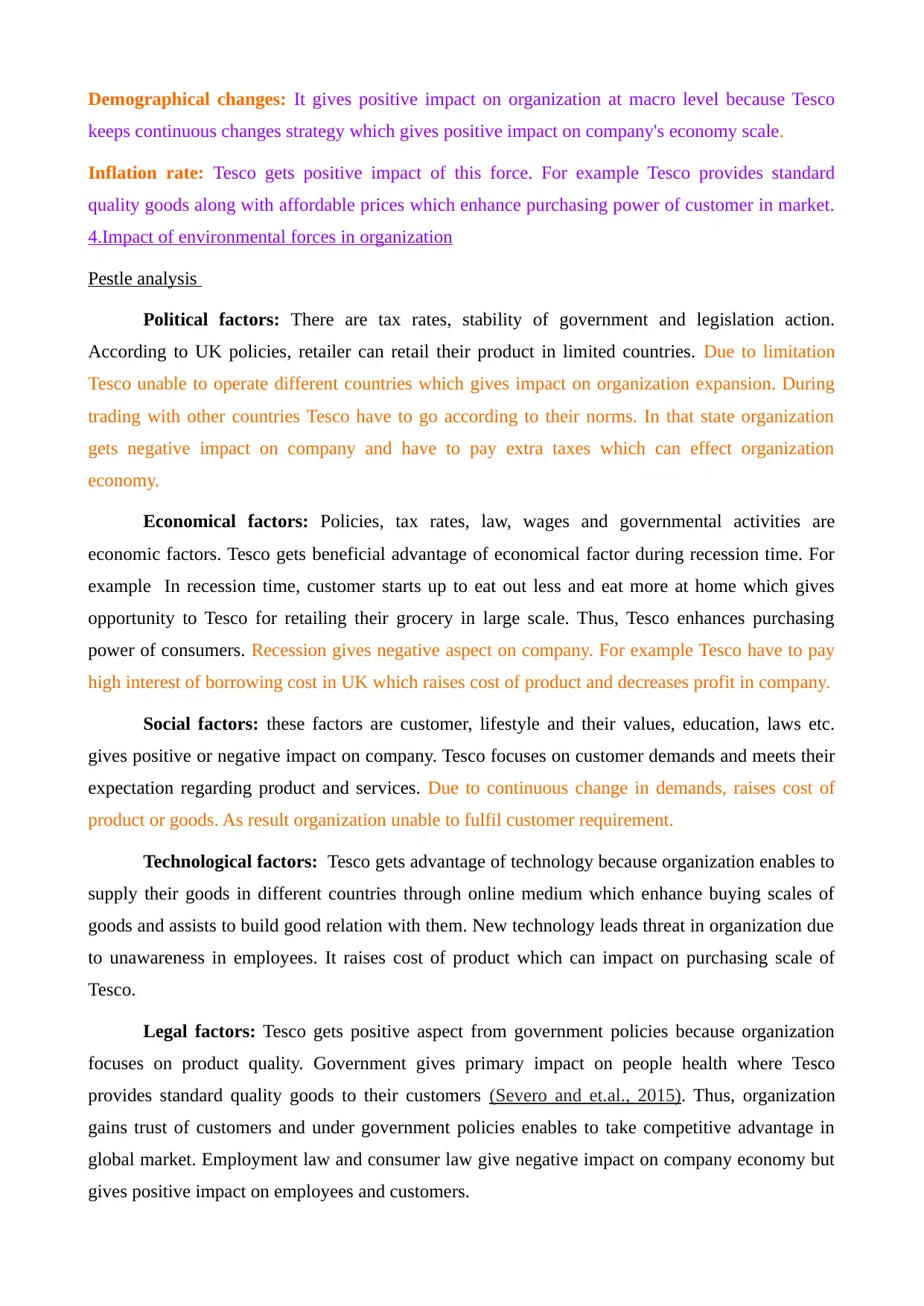
Demographical changes: It gives positive impact on organization at macro level because Tesco
keeps continuous changes strategy which gives positive impact on company's economy scale.
Inflation rate: Tesco gets positive impact of this force. For example Tesco provides standard
quality goods along with affordable prices which enhance purchasing power of customer in market.
4.Impact of environmental forces in organization
Pestle analysis
Political factors: There are tax rates, stability of government and legislation action.
According to UK policies, retailer can retail their product in limited countries. Due to limitation
Tesco unable to operate different countries which gives impact on organization expansion. During
trading with other countries Tesco have to go according to their norms. In that state organization
gets negative impact on company and have to pay extra taxes which can effect organization
economy.
Economical factors: Policies, tax rates, law, wages and governmental activities are
economic factors. Tesco gets beneficial advantage of economical factor during recession time. For
example In recession time, customer starts up to eat out less and eat more at home which gives
opportunity to Tesco for retailing their grocery in large scale. Thus, Tesco enhances purchasing
power of consumers. Recession gives negative aspect on company. For example Tesco have to pay
high interest of borrowing cost in UK which raises cost of product and decreases profit in company.
Social factors: these factors are customer, lifestyle and their values, education, laws etc.
gives positive or negative impact on company. Tesco focuses on customer demands and meets their
expectation regarding product and services. Due to continuous change in demands, raises cost of
product or goods. As result organization unable to fulfil customer requirement.
Technological factors: Tesco gets advantage of technology because organization enables to
supply their goods in different countries through online medium which enhance buying scales of
goods and assists to build good relation with them. New technology leads threat in organization due
to unawareness in employees. It raises cost of product which can impact on purchasing scale of
Tesco.
Legal factors: Tesco gets positive aspect from government policies because organization
focuses on product quality. Government gives primary impact on people health where Tesco
provides standard quality goods to their customers (Severo and et.al., 2015). Thus, organization
gains trust of customers and under government policies enables to take competitive advantage in
global market. Employment law and consumer law give negative impact on company economy but
gives positive impact on employees and customers.
keeps continuous changes strategy which gives positive impact on company's economy scale.
Inflation rate: Tesco gets positive impact of this force. For example Tesco provides standard
quality goods along with affordable prices which enhance purchasing power of customer in market.
4.Impact of environmental forces in organization
Pestle analysis
Political factors: There are tax rates, stability of government and legislation action.
According to UK policies, retailer can retail their product in limited countries. Due to limitation
Tesco unable to operate different countries which gives impact on organization expansion. During
trading with other countries Tesco have to go according to their norms. In that state organization
gets negative impact on company and have to pay extra taxes which can effect organization
economy.
Economical factors: Policies, tax rates, law, wages and governmental activities are
economic factors. Tesco gets beneficial advantage of economical factor during recession time. For
example In recession time, customer starts up to eat out less and eat more at home which gives
opportunity to Tesco for retailing their grocery in large scale. Thus, Tesco enhances purchasing
power of consumers. Recession gives negative aspect on company. For example Tesco have to pay
high interest of borrowing cost in UK which raises cost of product and decreases profit in company.
Social factors: these factors are customer, lifestyle and their values, education, laws etc.
gives positive or negative impact on company. Tesco focuses on customer demands and meets their
expectation regarding product and services. Due to continuous change in demands, raises cost of
product or goods. As result organization unable to fulfil customer requirement.
Technological factors: Tesco gets advantage of technology because organization enables to
supply their goods in different countries through online medium which enhance buying scales of
goods and assists to build good relation with them. New technology leads threat in organization due
to unawareness in employees. It raises cost of product which can impact on purchasing scale of
Tesco.
Legal factors: Tesco gets positive aspect from government policies because organization
focuses on product quality. Government gives primary impact on people health where Tesco
provides standard quality goods to their customers (Severo and et.al., 2015). Thus, organization
gains trust of customers and under government policies enables to take competitive advantage in
global market. Employment law and consumer law give negative impact on company economy but
gives positive impact on employees and customers.

Environmental factors: Tesco delivers their product in good packaging so that doesn't give
negative impact on goods or consumers. Thus, company keeps their goods organic quality and
decrease health issues of peoples. Beside of packaging there are lots of environmental issues like
pollution which gives negative impact on company.
Environmental forces impact at organization at industry and retail sector
These factor gives impact on organization because Tesco is retail sector which operates in
various countries and retail their product at large scale but government policies, technology, social
and cultural etc. are environmental forces which gives impact on organization performance. Such as
social cultural factor reduces performance of Tesco company due to continuous change in their
preferences while technological factor improves organization performance because it enhances
employees working efficiency and covers large number of customers. This factor gives postive
impact at retail level. While industry level environmental forces reduces performance of
organization because organization unable to replace their product continuous and new technology
increase cost of products.
5.Requirements of a variety of stakeholders in retail organization.
Tesco needs different types of stakeholders. These are-
Customers: In retailing sector, customers plays vital role who is a responsible for
organization performance. Tesco needs such kind customers who lead profitability in company and
retain prolong time in company (Jacobs, Swink and Linderman, 2015).
Employees: Employees also crucial part of organization who is a responsible to deliver
product or services to customer. Organization recruits those employees who posses quality to
interact with customers and enables to build good relation with customers. To retain such kind
employees, company focuses on their objectives and meets their objective, so that they provide best
services at workplace.
Shareholder: Shareholders also plays important role in company because they invest money
into the business and takes partnership in company. Tesco looking for potential shareholder who
enables to invest high cost and follows principle during partnership. Tesco provides profit margin to
shareholders so that investor provides funds to expand business in global market. Tesco meets
objective of shareholder by sharing profit of sale growth in company.
Distributors and other business partner: Tesco requires those kind stakeholder who leads
growth in company. For example suppliers are important part of company because they deliver
goods and services to customers and handles customer complaints and address company about
negative impact on goods or consumers. Thus, company keeps their goods organic quality and
decrease health issues of peoples. Beside of packaging there are lots of environmental issues like
pollution which gives negative impact on company.
Environmental forces impact at organization at industry and retail sector
These factor gives impact on organization because Tesco is retail sector which operates in
various countries and retail their product at large scale but government policies, technology, social
and cultural etc. are environmental forces which gives impact on organization performance. Such as
social cultural factor reduces performance of Tesco company due to continuous change in their
preferences while technological factor improves organization performance because it enhances
employees working efficiency and covers large number of customers. This factor gives postive
impact at retail level. While industry level environmental forces reduces performance of
organization because organization unable to replace their product continuous and new technology
increase cost of products.
5.Requirements of a variety of stakeholders in retail organization.
Tesco needs different types of stakeholders. These are-
Customers: In retailing sector, customers plays vital role who is a responsible for
organization performance. Tesco needs such kind customers who lead profitability in company and
retain prolong time in company (Jacobs, Swink and Linderman, 2015).
Employees: Employees also crucial part of organization who is a responsible to deliver
product or services to customer. Organization recruits those employees who posses quality to
interact with customers and enables to build good relation with customers. To retain such kind
employees, company focuses on their objectives and meets their objective, so that they provide best
services at workplace.
Shareholder: Shareholders also plays important role in company because they invest money
into the business and takes partnership in company. Tesco looking for potential shareholder who
enables to invest high cost and follows principle during partnership. Tesco provides profit margin to
shareholders so that investor provides funds to expand business in global market. Tesco meets
objective of shareholder by sharing profit of sale growth in company.
Distributors and other business partner: Tesco requires those kind stakeholder who leads
growth in company. For example suppliers are important part of company because they deliver
goods and services to customers and handles customer complaints and address company about
⊘ This is a preview!⊘
Do you want full access?
Subscribe today to unlock all pages.

Trusted by 1+ million students worldwide
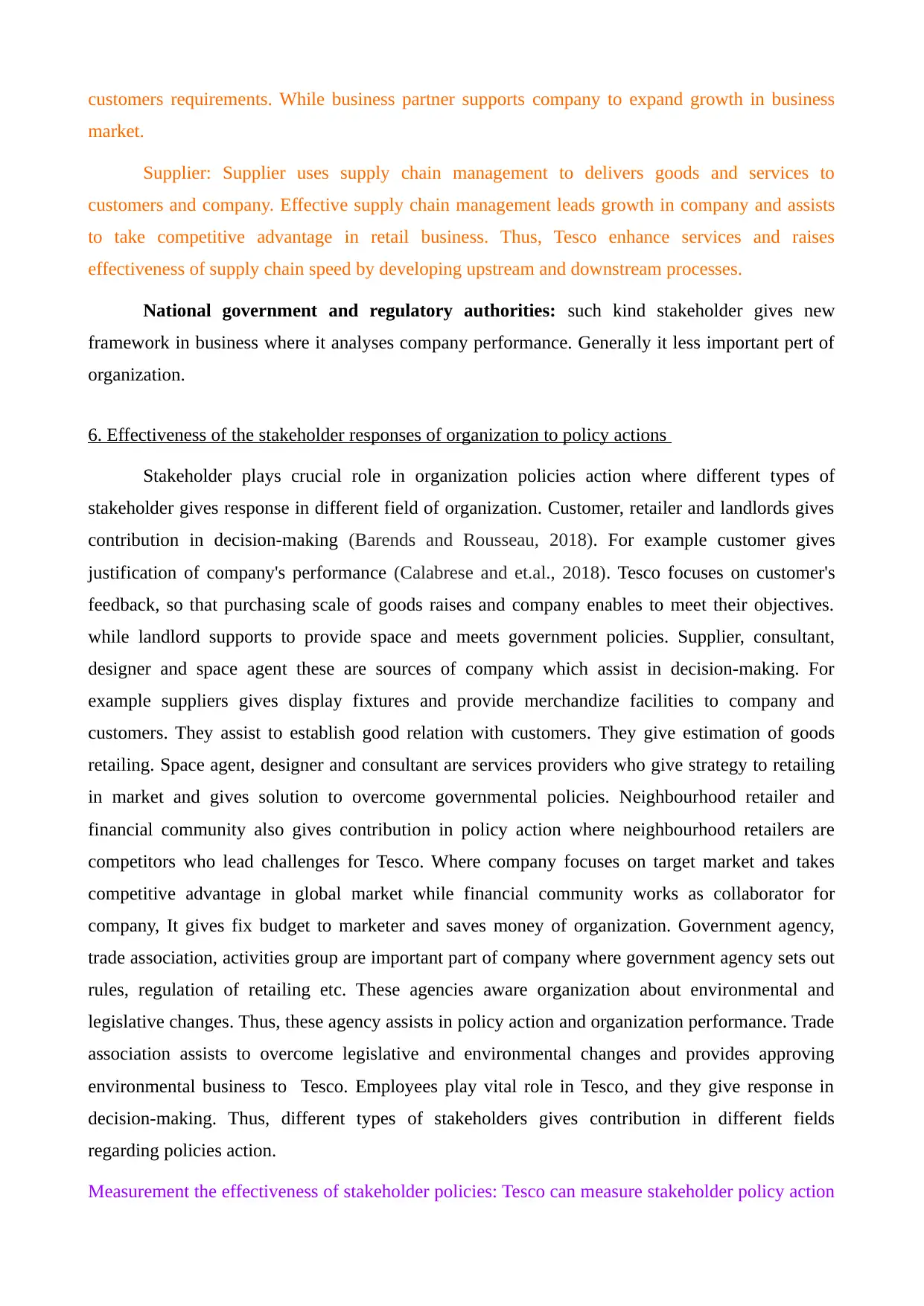
customers requirements. While business partner supports company to expand growth in business
market.
Supplier: Supplier uses supply chain management to delivers goods and services to
customers and company. Effective supply chain management leads growth in company and assists
to take competitive advantage in retail business. Thus, Tesco enhance services and raises
effectiveness of supply chain speed by developing upstream and downstream processes.
National government and regulatory authorities: such kind stakeholder gives new
framework in business where it analyses company performance. Generally it less important pert of
organization.
6. Effectiveness of the stakeholder responses of organization to policy actions
Stakeholder plays crucial role in organization policies action where different types of
stakeholder gives response in different field of organization. Customer, retailer and landlords gives
contribution in decision-making (Barends and Rousseau, 2018). For example customer gives
justification of company's performance (Calabrese and et.al., 2018). Tesco focuses on customer's
feedback, so that purchasing scale of goods raises and company enables to meet their objectives.
while landlord supports to provide space and meets government policies. Supplier, consultant,
designer and space agent these are sources of company which assist in decision-making. For
example suppliers gives display fixtures and provide merchandize facilities to company and
customers. They assist to establish good relation with customers. They give estimation of goods
retailing. Space agent, designer and consultant are services providers who give strategy to retailing
in market and gives solution to overcome governmental policies. Neighbourhood retailer and
financial community also gives contribution in policy action where neighbourhood retailers are
competitors who lead challenges for Tesco. Where company focuses on target market and takes
competitive advantage in global market while financial community works as collaborator for
company, It gives fix budget to marketer and saves money of organization. Government agency,
trade association, activities group are important part of company where government agency sets out
rules, regulation of retailing etc. These agencies aware organization about environmental and
legislative changes. Thus, these agency assists in policy action and organization performance. Trade
association assists to overcome legislative and environmental changes and provides approving
environmental business to Tesco. Employees play vital role in Tesco, and they give response in
decision-making. Thus, different types of stakeholders gives contribution in different fields
regarding policies action.
Measurement the effectiveness of stakeholder policies: Tesco can measure stakeholder policy action
market.
Supplier: Supplier uses supply chain management to delivers goods and services to
customers and company. Effective supply chain management leads growth in company and assists
to take competitive advantage in retail business. Thus, Tesco enhance services and raises
effectiveness of supply chain speed by developing upstream and downstream processes.
National government and regulatory authorities: such kind stakeholder gives new
framework in business where it analyses company performance. Generally it less important pert of
organization.
6. Effectiveness of the stakeholder responses of organization to policy actions
Stakeholder plays crucial role in organization policies action where different types of
stakeholder gives response in different field of organization. Customer, retailer and landlords gives
contribution in decision-making (Barends and Rousseau, 2018). For example customer gives
justification of company's performance (Calabrese and et.al., 2018). Tesco focuses on customer's
feedback, so that purchasing scale of goods raises and company enables to meet their objectives.
while landlord supports to provide space and meets government policies. Supplier, consultant,
designer and space agent these are sources of company which assist in decision-making. For
example suppliers gives display fixtures and provide merchandize facilities to company and
customers. They assist to establish good relation with customers. They give estimation of goods
retailing. Space agent, designer and consultant are services providers who give strategy to retailing
in market and gives solution to overcome governmental policies. Neighbourhood retailer and
financial community also gives contribution in policy action where neighbourhood retailers are
competitors who lead challenges for Tesco. Where company focuses on target market and takes
competitive advantage in global market while financial community works as collaborator for
company, It gives fix budget to marketer and saves money of organization. Government agency,
trade association, activities group are important part of company where government agency sets out
rules, regulation of retailing etc. These agencies aware organization about environmental and
legislative changes. Thus, these agency assists in policy action and organization performance. Trade
association assists to overcome legislative and environmental changes and provides approving
environmental business to Tesco. Employees play vital role in Tesco, and they give response in
decision-making. Thus, different types of stakeholders gives contribution in different fields
regarding policies action.
Measurement the effectiveness of stakeholder policies: Tesco can measure stakeholder policy action
Paraphrase This Document
Need a fresh take? Get an instant paraphrase of this document with our AI Paraphraser
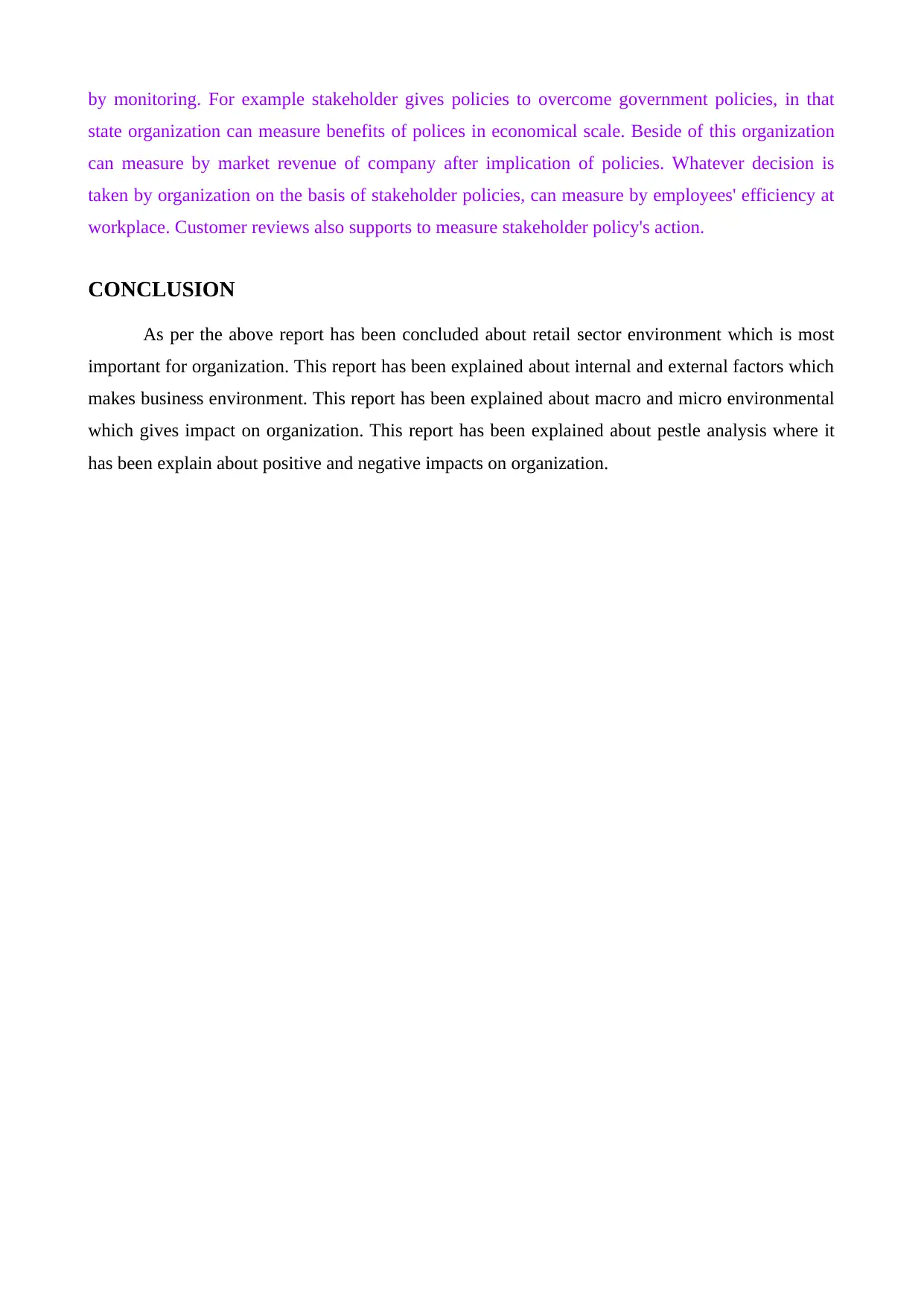
by monitoring. For example stakeholder gives policies to overcome government policies, in that
state organization can measure benefits of polices in economical scale. Beside of this organization
can measure by market revenue of company after implication of policies. Whatever decision is
taken by organization on the basis of stakeholder policies, can measure by employees' efficiency at
workplace. Customer reviews also supports to measure stakeholder policy's action.
CONCLUSION
As per the above report has been concluded about retail sector environment which is most
important for organization. This report has been explained about internal and external factors which
makes business environment. This report has been explained about macro and micro environmental
which gives impact on organization. This report has been explained about pestle analysis where it
has been explain about positive and negative impacts on organization.
state organization can measure benefits of polices in economical scale. Beside of this organization
can measure by market revenue of company after implication of policies. Whatever decision is
taken by organization on the basis of stakeholder policies, can measure by employees' efficiency at
workplace. Customer reviews also supports to measure stakeholder policy's action.
CONCLUSION
As per the above report has been concluded about retail sector environment which is most
important for organization. This report has been explained about internal and external factors which
makes business environment. This report has been explained about macro and micro environmental
which gives impact on organization. This report has been explained about pestle analysis where it
has been explain about positive and negative impacts on organization.

REFERENCES
Books and Journals
Akhtar, P and et.al., 2018. Essential micro‐foundations for contemporary business operations: Top
management tangible competencies, relationship‐based business networks and
environmental sustainability. British Journal of Management. 29(1). pp.43-62.
Alexiev, A.S., Volberda, H.W. and Van den Bosch, F.A., 2016. Interorganizational collaboration and
firm innovativeness: Unpacking the role of the organizational environment. Journal of
Business Research. 69(2). pp.974-984.
Barends, E. and Rousseau, D.M., 2018. Evidence-based management: How to use evidence to make
better organizational decisions. Kogan Page Publishers.
Baudry, G., Macharis, C. and Vallee, T., 2018. Range-based Multi-Actor Multi-Criteria Analysis: A
combined method of Multi-Actor Multi-Criteria Analysis and Monte Carlo simulation to
support participatory decision making under uncertainty. European Journal of Operational
Research. 264(1). pp.257-269.
Calabrese, M and et.al.,2018. From mechanical to cognitive view: The changes of decision making
in business environment. In Social Dynamics in a Systems Perspective (pp. 223-240).
Springer, Cham.
Jacobs, B.W., Swink, M. and Linderman, K., 2015. Performance effects of early and late Six Sigma
adoptions. Journal of Operations Management. 36. pp.244-257.
Kljucnikov, A and et.al.,2016. The entreprenurial perception of SME business environment quality
in the Czech Republic. Journal of Competitiveness. 8(1).
Madueño, J.H and et.al.,2016. Relationship between corporate social responsibility and competitive
performance in Spanish SMEs: Empirical evidence from a stakeholders’ perspective. BRQ
Business Research Quarterly. 19(1). pp.55-72.
Mark, J. and Nwaiwu, J.N., 2015. Impact of political environment on business performance of
multinational companies in Nigeria. African Research Review. 9(3). pp.1-10.
Severo, E.A and et.al., 2015. Cleaner production, environmental sustainability and organizational
performance: an empirical study in the Brazilian Metal-Mechanic industry. Journal of
Cleaner Production. 96. pp.118-125.
Books and Journals
Akhtar, P and et.al., 2018. Essential micro‐foundations for contemporary business operations: Top
management tangible competencies, relationship‐based business networks and
environmental sustainability. British Journal of Management. 29(1). pp.43-62.
Alexiev, A.S., Volberda, H.W. and Van den Bosch, F.A., 2016. Interorganizational collaboration and
firm innovativeness: Unpacking the role of the organizational environment. Journal of
Business Research. 69(2). pp.974-984.
Barends, E. and Rousseau, D.M., 2018. Evidence-based management: How to use evidence to make
better organizational decisions. Kogan Page Publishers.
Baudry, G., Macharis, C. and Vallee, T., 2018. Range-based Multi-Actor Multi-Criteria Analysis: A
combined method of Multi-Actor Multi-Criteria Analysis and Monte Carlo simulation to
support participatory decision making under uncertainty. European Journal of Operational
Research. 264(1). pp.257-269.
Calabrese, M and et.al.,2018. From mechanical to cognitive view: The changes of decision making
in business environment. In Social Dynamics in a Systems Perspective (pp. 223-240).
Springer, Cham.
Jacobs, B.W., Swink, M. and Linderman, K., 2015. Performance effects of early and late Six Sigma
adoptions. Journal of Operations Management. 36. pp.244-257.
Kljucnikov, A and et.al.,2016. The entreprenurial perception of SME business environment quality
in the Czech Republic. Journal of Competitiveness. 8(1).
Madueño, J.H and et.al.,2016. Relationship between corporate social responsibility and competitive
performance in Spanish SMEs: Empirical evidence from a stakeholders’ perspective. BRQ
Business Research Quarterly. 19(1). pp.55-72.
Mark, J. and Nwaiwu, J.N., 2015. Impact of political environment on business performance of
multinational companies in Nigeria. African Research Review. 9(3). pp.1-10.
Severo, E.A and et.al., 2015. Cleaner production, environmental sustainability and organizational
performance: an empirical study in the Brazilian Metal-Mechanic industry. Journal of
Cleaner Production. 96. pp.118-125.
⊘ This is a preview!⊘
Do you want full access?
Subscribe today to unlock all pages.

Trusted by 1+ million students worldwide

1 out of 10
Related Documents
Your All-in-One AI-Powered Toolkit for Academic Success.
+13062052269
info@desklib.com
Available 24*7 on WhatsApp / Email
![[object Object]](/_next/static/media/star-bottom.7253800d.svg)
Unlock your academic potential
Copyright © 2020–2025 A2Z Services. All Rights Reserved. Developed and managed by ZUCOL.





